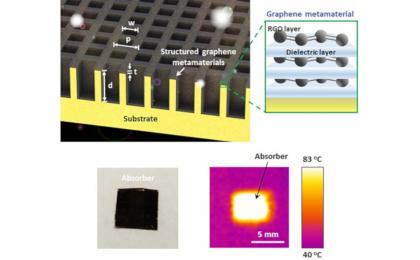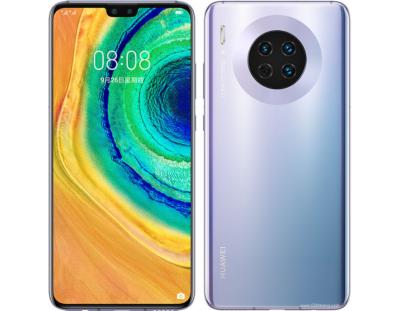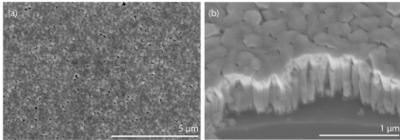Graphene thermal conductivity - introduction and latest news - Page 9
Researchers develop a graphene metamaterial film that absorbs sunlight with minimal heat loss
Researchers from Swinburne University developed a graphene-based highly efficient solar absorbing film that absorbs sunlight with minimal heat loss. The film rapidly heats up in an open environment and has great potential in solar thermal energy harvesting systems - in addition to other applications such as thermophotovoltaics (directly converting heat to electricity), solar seawater desalination, light emitters and photodetectors.

This is the 2nd-generation material developed by the same group - now with a thickness of only 30 nm and improved performance and longer lifetime. The researchers have now created a first prototype and also suggest a scalable low-cost manufacturing process.
New graphene-enhanced products raise old questions
When speaking of graphene in terms of commercialization, the general impression is that "a killer application has not yet been found". While this is not a false concept, it does not do justice with the now-budding graphene world. It can easily be stated that many graphene applications are being developed. This has been true for years, but various commercial products are starting to pop up, hopefully heralding the beginning of a more steady stream of commercialization.

Among these applications, one can point to cooling technology like Cryorig's CPU cooling system or Huawei's Mate 30 X smartphone, which sports a graphene film cooling technology. Various footwear and sports equipment products have also been launched, along with more technical products like oil additives and coatings. The list goes on and on, and there are even graphene-enhanced sanitary napkins on the market!
Cryorig launches graphene-enhanced cooling system for PCs
PC gear company Cryorig has introduced its low-profile CPU graphene-enhanced cooling system for small form-factor PCs that can dissipate up to 125 W. The Cryorig C7 G is among the smallest coolers for higher-end processors available today. To make C7 G's high performance possible, Cryorig applied graphene coating on the heatsink.

As demands arise for higher-performance components, cooling designers are creating low-profile coolers rated for TDP levels of 95 W of higher. To maximize efficiency of such devices, manufacturers use copper for heatsinks, many heat pipes, and large fans. Cryorig decided to go one step further and applied graphene coating to the radiator’s fins. Thermal conductivity of graphene is considerably higher than thermal conductivity of aluminum or copper, so applying it on the fins could theoretically improve cooling performance.
Applied Graphene Materials launches graphene-enhanced thermally conductive epoxy paste adhesives
 Applied Graphene Materials recently added new adhesive materials to their portfolio, aimed at the Space and Defense sectors. These are said to be two unique graphene-enhanced thermally conductive epoxy paste adhesive systems, called AGM TP300 and AGM TP400
Applied Graphene Materials recently added new adhesive materials to their portfolio, aimed at the Space and Defense sectors. These are said to be two unique graphene-enhanced thermally conductive epoxy paste adhesive systems, called AGM TP300 and AGM TP400
These novel epoxy adhesive systems reportedly exhibit high levels of thermal conductivity (between 3 and 6 W/mK), combined with excellent mechanical, adhesive and outgassing performance. Most significantly these properties are achieved with cured resin densities as low as 40% that of competitive conductive adhesives on the market. AGM’s TP 300/400 products are therefore highly versatile, while providing end users with significant savings in both mass and cost.
Researchers gain a better understanding of heat distribution processes
Understanding atomic level processes can open a wide range of prospects in nanoelectronics and material engineering. A team of scientists from Peter the Great St. Petersburg Polytechnic University (SPbPU) recently suggested such a model, that describes the distribution of heat in ultrapure crystals at the atomic level.
The distribution of heat in nanostructures is not regulated by the laws that apply to conventional materials. This effect is most vividly expressed in the reaction between graphene and a laser-generated heat point source.
Graphene and other 2D materials form an enhanced heat protector for electronics
Researchers from Stanford, NIST, Theiss Research and several others have designed a new heat protector that consists of just a few layers of atomically thin materials, to protect electronics from excess heat.
 Cross-section schematic of Gr/MoSe2/MoS2/WSe2 sandwich on SiO2/Si substrate, with the incident Raman laser
Cross-section schematic of Gr/MoSe2/MoS2/WSe2 sandwich on SiO2/Si substrate, with the incident Raman laser
The heat protector can reportedly provide the same insulation as a sheet of glass 100 times thicker. We’re looking at the heat in electronic devices in an entirely new way, said Eric Pop, professor of electrical engineering at Stanford and senior author of the study.
Huawei Mate P30 Pro adopts a graphene-based heat management film
In October 2018, Huawei announced its Mate 20 X smartphone, which was a gaming smartphone that adopted a graphene film cooling technology for heat management purposes. Now, Huawei launched the Mate P30 Pro smartphone, that adopts a graphene film as well.

The Mate 20 X was a bit of a niche phone, but the P30 Pro is more mainstream one (even though it is quite expensive at around $1,200). Besides the graphene cooling film, the P30 Pro sports a 6.47" 1080x2340 flexible AMOLED display, an under-the-display fingerprint sensor, a Kirin 980 chipset, 6/8 GB of RAM, 64/128/256/512 GB of storage a Nano Memory card slot and a high-end quad-camera setup.
A hands-on review of Wuxi Graphene Film's CVD graphene heating films
China-based Wuxi Graphene Film (owned by Grahope New Materials and The Sixth Element) produces patterned CVD graphene films for heating applications. These films are adopted by several Chinese device makers for different heating products - for example Grahope's graphene eye mask we recently reviewed at Graphene-Info.
The team at Wuxi Graphene Film was kind enough to send a few such films for us to review. These specific films are designed for one of WGF's customers and include a proprietary design which includes a USB connector for easy setup - you just plug these into a USB power source and the films heat up very quickly.
Grahope New Materials acquired 70% of Wuxi Graphene Film
Shenzhen-based Grahope New Materials (GNM) has acquired 70% of CVD graphene maker Wuxi Graphene Film from The Sixth Element Materials (who now holds 30% of WGF).
GNM focuses on the R&D of graphene heating technology and the development of graphene products in general. GNM adopts WGF's CVD graphene films in its products - for example in the graphene eye mask we recently reviewed at Graphene-Info.
Graphene serves as both substrate and transparent electrode in ultraviolet LEDs
Researchers at the Norwegian University of Science and Technology (NTNU) in Norway, Sophia University in Japan and SINTEF Industry, Norway have demonstrated the use of graphene as both a growth substrate and transparent conductive electrode for an ultraviolet light-emitting diode.
 Top- and bird-view SEM images of nanocolumns grown on DLG transferred onto amorphous silica glass
Top- and bird-view SEM images of nanocolumns grown on DLG transferred onto amorphous silica glass
The team focused on a flip-chip configuration, where GaN/AlGaN nanocolumns were grown as the light-emitting structure using plasma-assisted molecular beam epitaxy. Although the sheet resistance increased after nanocolumn growth compared with pristine double-layer graphene, the experiments showed that the double-layer graphene functioned adequately as an electrode. The GaN/AlGaN nanocolumns were found to exhibit a high crystal quality with no observable defects or stacking faults.
Pagination
- Previous page
- Page 9
- Next page

